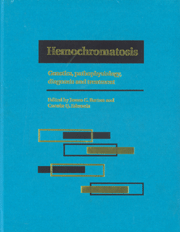Book contents
- Frontmatter
- Contents
- List of contributors
- Foreword
- Part I Introduction to hemochromatosis
- Part II Genetics of hemochromatosis
- Part III Metal absorption and metabolism in hemochromatosis
- 10 Intestinal iron-binding proteins
- 11 Intestinal iron absorption and hemochromatosis
- 12 The absorption and metabolism of non-ferrous metals in hemochromatosis
- 13 Ferritin metabolism in hemochromatosis
- 14 Hepatic iron metabolism in hemochromatosis
- 15 Extra-hepatic iron metabolism in hemochromatosis
- 16 Mathematical models of metal metabolism in hemochromatosis
- 17 Expression of iron overload in hemochromatosis
- Part IV Diagnostic techniques for iron overload
- Part V Complications of iron overload
- Part VI Therapy of hemochromatosis and iron overload
- Part VII Infections and immunity in hemochromatosis
- Part VIII Hemochromatosis heterozygotes
- Part IX Relationship of hemochromatosis to other disorders
- Part X Animal models of hemochromatosis and iron overload
- Part XI Screening for hemochromatosis
- Part XII Hemochromatosis: societal and ethical issues
- Part XIII Final issues
- Index
17 - Expression of iron overload in hemochromatosis
from Part III - Metal absorption and metabolism in hemochromatosis
Published online by Cambridge University Press: 05 August 2011
- Frontmatter
- Contents
- List of contributors
- Foreword
- Part I Introduction to hemochromatosis
- Part II Genetics of hemochromatosis
- Part III Metal absorption and metabolism in hemochromatosis
- 10 Intestinal iron-binding proteins
- 11 Intestinal iron absorption and hemochromatosis
- 12 The absorption and metabolism of non-ferrous metals in hemochromatosis
- 13 Ferritin metabolism in hemochromatosis
- 14 Hepatic iron metabolism in hemochromatosis
- 15 Extra-hepatic iron metabolism in hemochromatosis
- 16 Mathematical models of metal metabolism in hemochromatosis
- 17 Expression of iron overload in hemochromatosis
- Part IV Diagnostic techniques for iron overload
- Part V Complications of iron overload
- Part VI Therapy of hemochromatosis and iron overload
- Part VII Infections and immunity in hemochromatosis
- Part VIII Hemochromatosis heterozygotes
- Part IX Relationship of hemochromatosis to other disorders
- Part X Animal models of hemochromatosis and iron overload
- Part XI Screening for hemochromatosis
- Part XII Hemochromatosis: societal and ethical issues
- Part XIII Final issues
- Index
Summary
Introduction
The amount of body iron stores is a major determinant of clinical outcome in patient with hemochromatosis. Patients with greater iron overload, as assessed by hepatic iron concentration (HIC) and/or the amount of total iron removed by phlebotomy (IR), have an increased prevalence of diabetes, cardiomyopathy and hypogonadism and an increased risk of mortality. HIC greater than 400–500 mmol/g is an important risk factor for hepatic fibrosis and cirrhosis. In contrast, arthropathy is unrelated to iron stores and, unlike other clinical manifestations, is not significantly improved by phlebotomy therapy. It is generally accepted that the liver is the first site of iron deposition in persons with hemochromatosis, and that other organs are involved later. Previous studies have suggested that there may be a threshold in the liver for iron accumulation. Mandelli et al. showed that the increases of HIC became progressively smaller until HIC plateaus at a value of ∼350 mmol, after which iron accumulation progresses in extrahepatic sites as shown by the increase of both serum ferritin concentration and IR, and by the higher frequency of clinical extrahepatic manifestations excluding arthropathy.
Factors affecting the expression of iron overload
The degree of iron overload and the related clinical complications vary widely in hemochromatosis and both acquired and genetic factors influence phenotypic expression of the disease.
- Type
- Chapter
- Information
- HemochromatosisGenetics, Pathophysiology, Diagnosis and Treatment, pp. 177 - 184Publisher: Cambridge University PressPrint publication year: 2000
- 2
- Cited by



